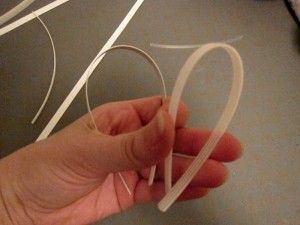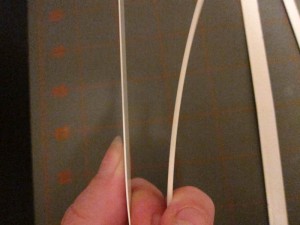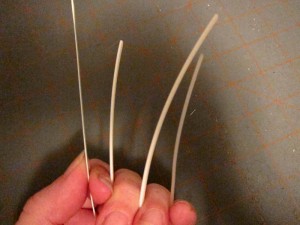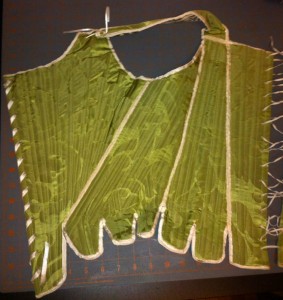I’ve been meaning to write this for a while, and finally got organized!
When I went to make my handsewn 1780s stays, I was trying to be as historically accurate as possible, and that brought up the question of boning — what to use? Obviously in the period whalebone was the desired boning, but we can’t get it today and even if we could, I don’t believe in killing endangered species for my hobby/research (sorry, please don’t start telling me about Inuits — THEY’RE AN ENDANGERED SPECIES! Whales, that is).
Most modern costumers who are trying to be as historically accurate as possible use cane/reed. I’ve got an issue with this, and while I posted briefly about boning here, but I realized that I had most of the discussion on LJ.
Here’s my logic: in the period, whalebone was THE preferred boning. Yes, cane/reed were used, but they were considered a substandard material and generally used on homemade (ie not professionally made) stays. Ask anyone who’s made a corset with reed/cane and had it break on them why!
I’m not just talking out of my you-know-what, here’s the research:
The best source is: Dorsey, S.. “For neatness, true fitting, shape and fashion”: The craft and consumption of stays in eighteenth century America. M.A. diss., University of Delaware. Anyone with access to a university library can get a PDF copy of this thesis from the database ProQuest Dissertations & Theses.
Dorsey writes: “The most important part, however, were the “stays” themselves: the garments’ main structural support. The rigid inserts were made from a variety of materials such as wood, thread, and whalebone. Whalebone, otherwise known as baleen, was the most common material and the most expensive. Cheaper alternatives included the use of split wood, steel, pack-thread, and pasteboard.(100) Of those, most pairs of surviving American non-baleen stays are boned with wood. The wooden inserts appear to be made out of riven hardwoods (Figures 21 a and b). Wood is also particularly susceptible to fluctuations in humidity and stress. Over time wood becomes brittle and snaps in two at the stress points, usually on the curve of stay tabs. For this reason it was not an ideal material to use and is typically seen on stays made by an amateur.(101) “Packthread” stays are seen in American stay maker advertisements, where they are also noted to have been imported to America. Packthread is a strong cord or twine made of coarse flax or hemp plied together. Baldwin and Hyer, for example, wrote “that they make Stays with Whale-Bone, which are far preferable for Ease and Genteelness, to those imported from England, that are made of Packthread.”(102) Indeed, whalebone was seen as the superior material in stay making.(103)
(100) Rushes are known to have been used in seventeenth-century stays and were likely used in the eighteenth century. However, in the survey of American stays conducted for this thesis, no pairs were found to exhibit them. Some historians note that bone and ivory were used, but as Mark Hutter pointed out, they would have been too rigid and brittle to function as anything else other than busks. Mark Hutter, email with author, 24 March 2008.
(101) There are no advertisements for wooden stays, it is more likely that they were made by persons who could not afford whalebone (baleen) or the services of a professional stay-maker. Haughland, “Common Cotton,” 3.
(102) Baldwin and Hyer, New York Mercury (New York, NY) 20 May 1765.
(103) Sorge-English, ’29 Doz and 11 Best Cutt Hone’, 30.”
(Bolding is mine)
*************
Norah Waugh in Corsets & Crinolines goes far less into this topic, but she does say briefly, in her appendix on whalebone: “When stiffened bodies and farthingales appeared in the sixteenth century it could not have been long before the superiority of whalebone over wood and cane supports brought it into use wherever available” (168).
*************
Lynne Sorge-English has two articles that are related & interesting. She mentions that whalebone was by far the most popular boning in the 18th c. in: Lynne Sorge-English, “’29 Doz and II Best Cutt Bone’: The Trade in Whalebone and Stays in Eighteenth-Century London.” Textile History v. 36 no. 1 (may 2005): 20-45. The other article, which doesn’t go into this topic but is still very interesting, is: Lynn Sorge, “Eighteenth-Century Stays: Their Origins and Creators.” Costume 32 (1998): 18-32. She’s now come out with a book that I haven’t yet read, but is on my wishlist: Stays and Body Image in London: The Staymaking Trade, 1680-1810 (The Body, Gender and Culture) (full disclosure: I’m an Amazon Associate and buying from that link will send me a couple of cents).
**************
So to my logic, yes reed/cane is an historically accurate material that we can still get, while whalebone is not something we can get ethically or practically. Since I was trying to make a pair of stays appropriate to an upper class woman, I needed an equivalent to whalebone, not the boning material that would have been used in substandard stays. The properties of whalebone that made it so popular for corsetry was the fact that you could cut it to any width/length/thickness, and the fact that it molds to the body over time.
Now, we come to our modern boning products, most of which are accurate to the Edwardian era or sometime in the 20th century. For a good rundown, I recommend Sarah’s “Various Boning Options for Historical Corsetry” and Jenny-Rose’s “A Word on Boning.”
The main boning type that neither of them discuss is the plastic boning made by Wissner, a German company and so hence often called “German plastic boning.” I had heard good things about this boning material — that it is very comparable to whalebone in terms of support and its ability to mold to the figure — so I decided to try it out, and used it on the handsewn (green) version of my stays.
So, the report!
In the past I have used spring steel (aka white steel), spiral steel, and the crappy plastic boning sold at Joann’s (don’t even get me started). I haven’t used cable ties or cane/reed or any of the other strange and wonderful things you can use as boning! Now that I’ve made up my stays and worn them for over a a year, I can say that the German plastic gives you way more support than the crappy Joann’s plastic, more support than the spiral, and a little bit less support (but not much) than spring steel. In my stays I decided to reinforce things with spring steel at the CF and CB, as well as at 3 points throughout the front piece. I’m currently working on a corset (more on that soon) and just tried it out with only spring steel at the CF and CB, and I felt like I did want one or two more spring steel bones in front.

The best part about the German plastic is it DOES mold to your form. Here’s one half of my 1780s stays laid flat on my cutting table. You can see how the tabs have formed themselves to the shape of my hips:
In addition to its support qualities, you can buy German plastic boning in a number of widths. It’s sold in thicknesses from 13 to 5 millimeters (1/2″, .4″, 1/4″, and 3/8″) at the place I buy from (more on this in a sec). This means you can make corsets with finer boning channels, like this gorgeous pair of stays made by The Staymaker. Here’s a photo of some of the boning I have on hand:

It is a bit thicker than spring steel, so you’ll want to add a little bit (maybe 1/8″?) to your boning channels to accomodate this.


The German plastic comes in rolls, which means you can cut it to size, and unlike steel you don’t have to use complex tools or dip the ends to cut it (a pair of scissors works just fine).
In terms of where to buy it, the main source in the US (and where I order from) is Vogue Fabrics. They sell all the various widths, and you can buy in rolls of 25 meters or 100 meters. Farthingale’s Canada also sells it, but their website is so annoying I’ve never bothered to figure out if it’s more/less expensive. In the UK, you can buy it from Vena Cava Designs.

I’ve been using German plastic whalebones for years and I think they work excellently. For my ample figure they are not quite up to half-boned, but I suspect it is because my figure aren’t really up to half-boned stays… Fully boned ones work a treat, though. I would love to figure out a painless way of splitting them in the middle to make them even thinner as I think the really narrow channels looks so neat.
Have you seen Stay-ing Alives posts about making stays with whalebones? She managed to get her hand on etichally harvested ones from a stranded whale:
http://stay-ingalive.blogspot.se/
I also really like these stays , with cane boning, but a lovely execution:
http://augustintytar.blogspot.se/2012/05/1780s-stays-2012.html
I find making stays very addictive and with so much talk about it lately I feel the urge creeping up on me again.
I’m completely with you on this: “Here’s my logic: in the period, whalebone was THE preferred boning. Yes, cane/reed were used, but they were considered a substandard material and generally used on homemade (ie not professionally made) stays. ”
And because I’m also with you on the baleen issue, I’ve also been forced to make a decision which compromise material to use. I don’t know if it’s just luck or a matter of how each of our bodies are unique, but since I haven’t had trouble with cane, I’ve continued using it. Not because it’s vaguely historically accurate, but because it’s cheap, comfortable, conforming, easy to handle and because it can easily be made even down to 2 mm wide strips that was needed for my newest pair. I would even be prepared to replace some of the boning if they would ever break on me. That wouldn’t bother me.
But you have raised a good question of which material would give the right look. I’ve been happy with how they look now that they are boned with cane but I can only hope they don’t look bad (or too lower class for their design) when observed by more experienced eyes.
Dang, now I want to try the German stuff! I kind of suspect it would feel & behave very similar to cable ties, but the main difference being that the German plastic boning comes in a variety of widths & thicknesses. Cable ties come in different lengths, but one thickness. However, cable ties are cheap & can be found in any hardware store (no need to mailorder). Cable ties can also be cut with scissors, tho I like to file the ends round w/a dremel tool & I’m guessing you could do the same w/the German plastic.
My pink Florentine gown is boned w/cable ties & feels very sturdy & comfortable, very similar to the reed-boned Elizabethan stays Sarah made for me (that are 4 years old & going strong!). If I had a German plastic boned corset, then I’d have one of each, for a complete comparison….
If reed/cane has worked well for you, then go for it — I’m not snobby about what I use, I just want whatever has the closest effect to whalebone!
Isis: sadly, I’d disagree that there is any ethically harvested whalebone. Yes, Inuits are allowed to hunt whales & use their products, but they’re only allowed to sell (to non-Inuits) finished items made from whale products — not whale materials themselves. And even if you could buy it legally, I still consider it unethical, because you’re contributing to the demise of an endangered species!!
I haven’t tried cable ties but I suspect they’re somewhat like the German plastic, but yes, can’t get different widths, which makes me un-excited about it. I really like being able to use narrower widths, I think it looks so much finer!
Oh, and Isis — that pair of stays you linked to are JAW DROPPING. WHOA.
Kendra, In my research on 18th century New England stays, I have found boning other than whalebone, but it is wood, not cane or reed. It is either oak or ash (very difficult to tell which). I also own a pair of 18th c stays made with wood in the channels. The stays with wood are not high end, but they follow all the conventions of stay making, just not to the level of a pair made by a master stay maker in England, and I doubt if they were homemade. I find many pairs of New England stays to be more primitive (variable quality of channel stitches etc) , but still follow all the techniques in construction of those of a master pair. I have used the “false whalebone” for years, and buy it directly from Wissner. I used it to make a recreation of a 17th c pair of stays in the collection of Pilgrim Hall in Plymouth, Mass for an exhibit. I could not have done it without the narrow (4mm) plastic boning, any reed or cane would have bent or broken , the fully boned pair were surprisingly sturdy in the end when fully boned.
http://18thcstays.blogspot.com/p/17th-century-stays-recreation.html
Hallie
Kendra,
Not to stir up too much discussion in this area, as I am against using whale baleen as well. However, if I whale is stranded & has already died, I do not see that as unethically harvesting products from it….. This of course if it has already died by some means unknown to us….. That is how the NC State Museum of Natural History actually acquired it’s whale so very long ago. It died on our coastline, though no means related to man hunting or injuring the whale.
Anyway, other than that, I agree with you. And I thank you for your excellent comparision & discussion & especially the documentation you have provided. Thank you! Thanks for all the links as well. I have them all opened on tabs so as to do further reading. Thanks again for your standards of accuracy.
“Now that I’ve made up my stays and worn them for over a a year, I can say that the German plastic gives you way more support than the crappy Joann’s plastic, more support than the spiral, and a little bit less support (but not much) than spring steel.”
It’s surprisingly hard to find people talking about German plastic boning in a positive light. We use it in all of the corsets we produce, to great effect, but I still find myself wondering if I’m just not understanding something when I read articles about plastic stays being cheap, easily broken, inferior in every way.
I wrote my own post on the subject here: https://www.fiendishimp.com/2019/04/03/steel-vs-plastic-boned-corsets/
I realize the post I’m commenting on is seven years old, but on the offchance that you’re still getting comment notifications I would be interested to know if you’ve continued to have success and use synthetic whalebone.